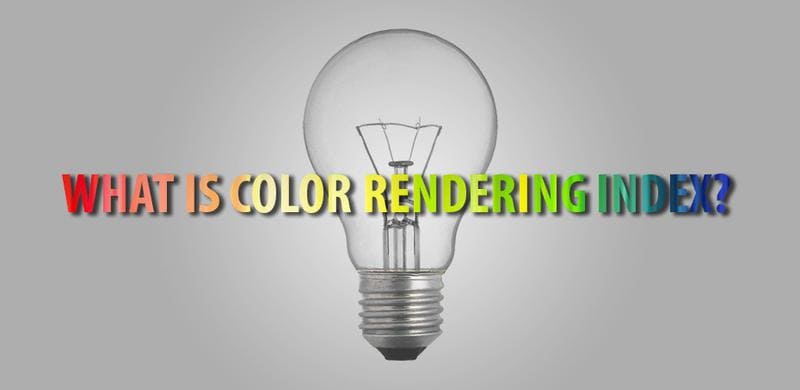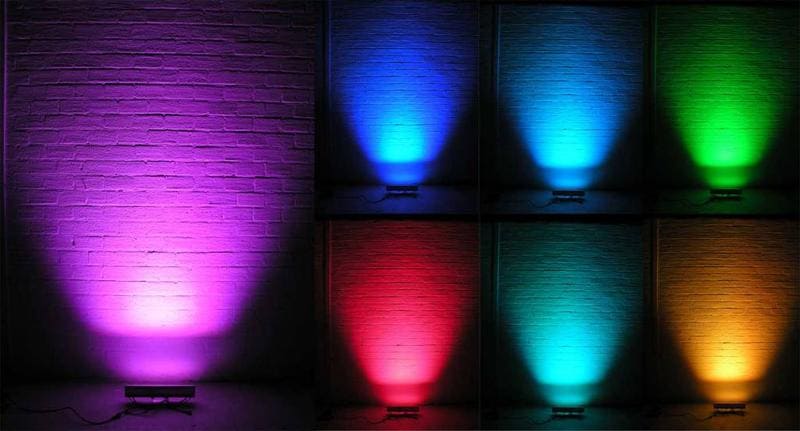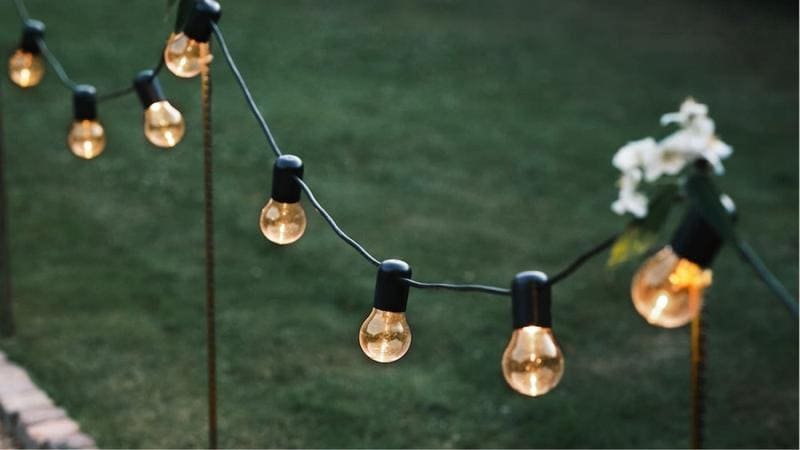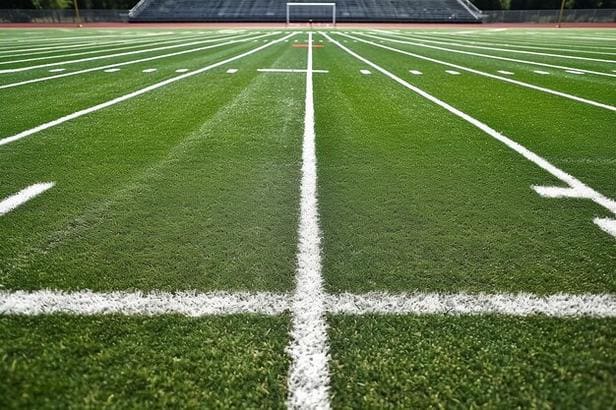Lighting is a pivotal element in creating a unique shopping environment that attracts customers, draws them in, and establishes a distinct store personality while reflecting the brand’s identity. Successful retail lighting is not a one-size-fits-all solution; it requires a strategic mix of color, contrast, control, and energy efficiency. Beyond application knowledge and experience, it demands proper implementation and advanced lighting techniques utilizing the latest lamp and luminaire technology. When customers are excited about their shopping experience, they tend to stay longer, spend more, and are more likely to return and enjoy coming back.
LEDAPLUS is dedicated to guiding you through the retail lighting process, serving as your comprehensive lighting resource. We are uniquely qualified to meet your retail store lighting needs, offering a variety of lighting systems, including track, recessed, and decorative options, to keep stores fresh and up-to-date. Ensuring that your investment in lighting yields positive returns on your bottom line takes time and effort, and LEDAPLUS is committed to partnering with you every step of the way.
Goals of Retail Lighting Design
A successful lighting design is predicated upon both the quantity and quality of illumination. It must influence perceptions about the merchandise and enhance the overall appearance of the retail space. A designer must judiciously consider various essential characteristics when developing their lighting strategy, including lamp longevity, system efficiency, lumen maintenance, color rendering and appearance, daylight integration and control, light distribution, points of interest, cost, system control, and flexibility.
- Attract Customers: Entice shoppers into the store and guide them through the space safely and effectively.
- Reinforce Brand Identity: Convey brand image and give impressions about the store’s image and price range.
- Create Aesthetically Pleasing Environment: Provide a sense of comfort and well-being for customers, creating an inviting shopping atmosphere.
- Showcase Merchandise: Highlight features and displays, and enhance colors, textures, and forms while minimizing glare.
- Promote Merchandise Evaluation: Facilitate the examination of products to encourage purchases.
- Enable Sales Completion: Assist in the finalization of transactions.
- Reduce Energy Costs: Implement energy-efficient lighting solutions to minimize operational expenses.
With technological advancements such as smartphones and tablets, the customer journey often transcends the physical store. Brand image and the overall shopping experience have become more critical than ever. Lighting plays a pivotal role in conveying a specific retail message; it sets customer expectations regarding merchandise quality and influences their motivation to make a purchase. Selecting the appropriate lighting is essential for projecting the desired store image, focusing and attracting customer attention, and enhancing the appeal of merchandise, ultimately leading to purchases. Lighting solutions must be tailored to the target market, store concept, and brand image, as the optimal lighting will distinguish your store from competitors.
A well-illuminated store is directly linked to increased profitability. Instead of merely increasing brightness, which leads to higher energy consumption, high-contrast lighting should be employed. This approach makes perception easier and heightens attention levels.
- Diffused General Lighting: Provides a sense of well-being, creating a welcoming atmosphere.
- Vertical Illuminance: Facilitates orientation within the space, helping customers navigate the store more effectively.
- Accent Lighting: Enhances the perception and attractiveness of displayed goods by focusing light on specific products or areas, drawing attention and making key merchandise stand out.
The sales floor is where the brand truly comes to life. Therefore, goods must be presented as true-to-life as possible. Using high CRI (Color Rendering Index) light sources and a well-balanced mix of lighting achieves this, ensuring that colors appear vibrant and accurate.
Given that products, offers, and displays frequently change in a retail setting, lighting systems must be highly flexible. This flexibility allows for easy adjustments, ensuring the store always maintains a fresh and contemporary appearance. Adapting the lighting to new displays or promotional areas helps maintain customer interest and engagement.
In conclusion, thoughtful and strategic use of lighting in retail environments is essential for creating an appealing shopping experience, reinforcing the brand image, and ultimately driving sales. By considering various lighting types and their specific benefits, retailers can enhance the overall ambiance of their stores, making them more attractive and welcoming to customers.

Color, Reflection, & Contrast in Retail Lighting
Effective retail lighting is a sophisticated balance of numerous elements. The merchandise on display, the dimensions and configuration of the space, the target demographic, and the brand’s intended message all play pivotal roles. The interplay of color, reflection, contrast, and energy efficiency is fundamental to a successful retail lighting design.
The color properties of light sources are defined by two key measurements: Correlated Color Temperature (CCT) and Color Rendering Index (CRI).
Selecting lighting with optimal color properties is essential. The right color temperature and CRI are critical in enhancing the appearance of merchandise and influencing the overall atmosphere of the retail space. This alignment is pivotal in reinforcing the store’s image and creating an inviting environment.
Not all light sources are created equal. Two white lights may appear similar but can render colors differently or evoke distinct spatial perceptions. Employing lamps with the same CCT and comparable CRI ensures consistent and uniform illumination throughout the space.
Reflection and glare, while potentially beneficial, can also be detrimental if mismanaged. Properly used, they can draw attention to merchandise. Misapplied, they can cause irritation and discomfort.
Luminaires with high glare reduction values are essential to avoid direct glare and undesirable reflections on shiny surfaces, such as glossy fixtures, cash registers, and PIN pads.
A very bright store is not necessarily the most effective lighting solution. Utilizing contrast to highlight merchandise and delineate different areas within the space makes customers feel more at ease and directs their attention to featured products.
Correlated Color Temperature
Correlated Color Temperature (CCT) quantifies the hue of a lamp’s emitted light. Each lamp is assigned a color temperature reflecting the color it radiates. White light is generally categorized into three segments: warm, neutral, and cool, all measured in Kelvin (K).
- Warm White (below 3000K): This category of light, reminiscent of candlelight with a yellowish hue, enriches reds and oranges, subdues blues, and imparts a yellow tint to whites and greens. It creates a cozy, intimate ambiance.
- Neutral White (3000K – 3500K): Neutral white light enhances colors evenly without emphasizing yellow or blue. This balanced illumination is conducive to an environment of general well-being.
- Cool White (above 3500K): Similar to moonlight on snow with its bluish tint, cool white light enhances blues, mutes reds, and gives whites and greens a bluish cast. It imparts a sense of spaciousness to the area.
Warm lighting tends to make spaces feel more intimate, comfortable, and familiar, thus fostering a welcoming atmosphere. In contrast, cool lighting can make areas appear larger and more expansive. Neutral lighting, by promoting a sense of well-being, may encourage customers to linger longer in the store, potentially increasing purchase likelihood.
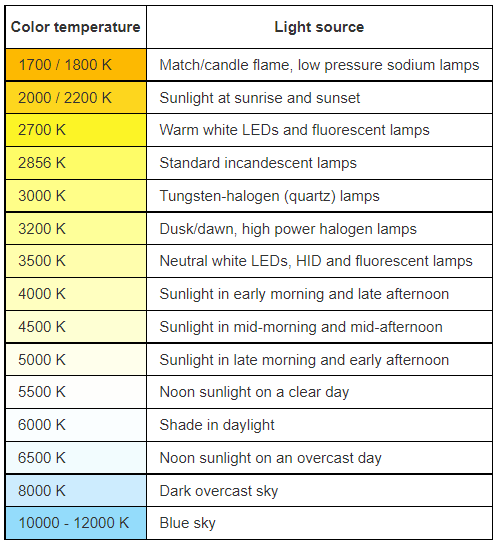
Color Rendering Index
The Color Rendering Index (CRI) is an evaluative metric that gauges how accurately a light source reproduces the colors of objects in comparison to a reference light source. This index is particularly useful for comparing light sources of the same type and Correlated Color Temperature (CCT).
To determine CRI, a standard palette of specific colors is utilized. The calculation involves measuring the difference between each color sample when illuminated by the test light source and the reference source. These differences are averaged to yield a score ranging from 0 to 100, with 100 representing the closest match between the test and reference light sources.
A higher CRI indicates superior color rendering capabilities, making colors appear more vibrant and natural. For retail environments, where products need to be displayed in a manner that is as true-to-life as possible, a CRI value between 80 and 100 is recommended. This level of accuracy not only enhances the aesthetic appeal of the merchandise but also bolsters the store’s credibility.
Reflection
In lighting design, the reflection of light off various surfaces within a space must be meticulously considered. Surfaces with higher reflectance levels bounce light back into the area, thereby increasing overall illuminance. Light reflectance is measured on a scale from 0, indicating total light absorption, to 100, indicating total light reflection.
Materials that provide spread reflection, such as brushed aluminum, exhibit high yet diffused reflection, reflecting approximately 5-10% of light. Diffused reflection materials, like a simple white-painted wall, offer uniform brightness and serve as excellent reflective backgrounds for coves and smaller spaces. Utilizing white and light-reflective surfaces not only reduces energy costs but also mitigates shadows caused by racks and stacked goods, thereby enhancing the visual appeal and functionality of the retail environment.
| MATERIAL | REFLECTANCE PERCENT |
|---|---|
| Diffuse: Uniform surface brightness | |
| Limestone | 35-60 |
| White Paint | 75-90 |
| White Structural Glass | 70-80 |
| Spread: General diffuse reflection | |
| Brushed Aluminum | 55-60 |
| Etched Aluminum | 70-82 |
| Processed Aluminum (Diffuse) | 70-80 |
| Satin Chrome | 50-55 |
| Specular: Directional control of brightness at specific angles | |
| Chrome | 60-65 |
| Metal coated plastic | 75-95 |
| Mirrored and optical-coated glass | 80-95 |
| Polished aluminum | 69-70 |
| Stainless Steel | 55-65 |
Contrast Ratios
In retail environments, creating a comfortable atmosphere for patrons while highlighting key merchandise and store areas is paramount. Merely increasing brightness is not only inefficient in terms of energy consumption but also ineffective in achieving the desired ambiance. Overly bright stores with excessive glare can make customers uncomfortable, reducing the likelihood of return visits. The solution lies in layering light and employing contrast throughout the space.
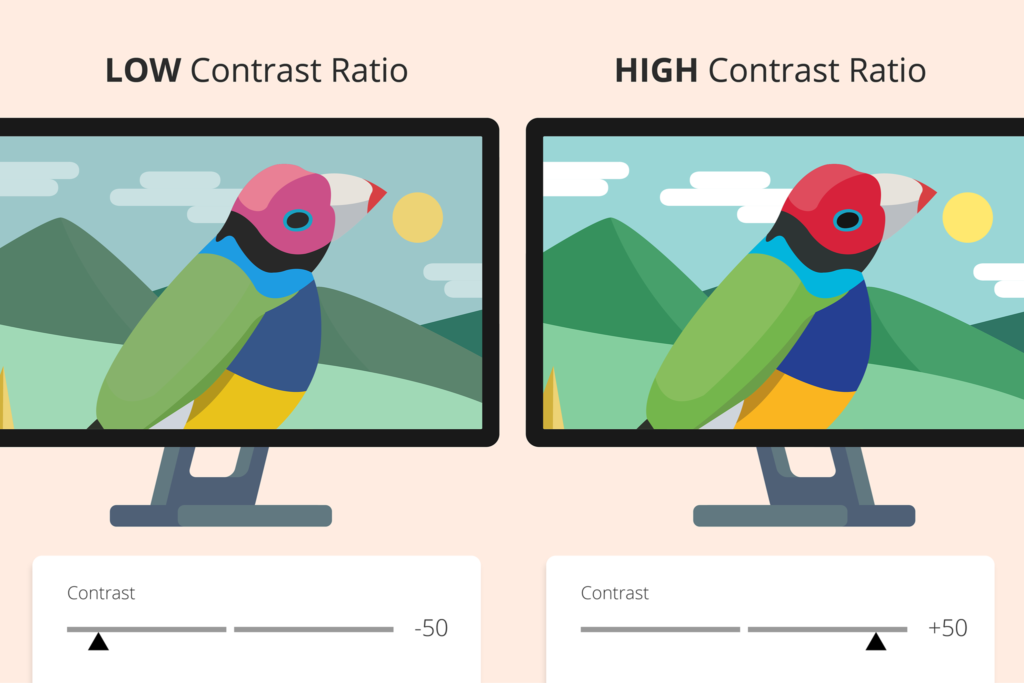
CONTRAST RATIOS
There are four fundamental layers of retail lighting: general (or ambient) lighting, accent lighting, task lighting, and decorative lighting. These layers are measured in footcandles, with the Illuminating Engineering Society of North America (IESNA) providing illuminance level recommendations based on the type of lighting, the nature of the space, the profile of the customer, and the intended use of the lighting. By layering these different types of lighting, depth and dimension are introduced into the space.
Contrast is achieved by varying the illumination levels among the different types of lighting, particularly task and accent lighting, to emphasize featured merchandise against the general light levels. Contrast can create visual hierarchies within the retail environment, directing and focusing attention on specific merchandise based on the contrast ratio. For instance, a 2:1 contrast ratio, where accent lighting is twice as bright as general lighting, creates a subtle differentiation. Conversely, a 30:1 contrast ratio produces a pronounced focal effect on highlighted items.
Each type of lighting offers numerous options, and by incorporating the recommended light levels and contrast ratios, the resulting space boasts high visual interest, depth, and dimension.
The following table shows the recommended color temperatures and recommended CRI for different types of stores.
| Type of Store | Color Rendering Index (CRI) | Correlated Color Temperature(K) |
| Butcher shop | >80 | 2500 – 3000 or LED lights with spectrum for meat lighting |
| Fish | >80 | silver, blue fish >5000Κ, with and gold fish 4000Κ, red fish <4000Κ |
| Bakery | >80 | 2500Κ – 3000Κ |
| Greengrocer’s | >80 | fruits (apples. oranges, etc): 2700K -3000K green vegetables: 4000Κ |
| Clothing / fashion store | >90 | 3500 – 4000 |
| Sport equipment | >80 | 4000 |
| Shoes / leather | >80 | 3000 – 4000 |
| Jewelry, watches, optics | >80 | 2700 – 4000 |
| Perfumes, pharmacies | >80 | 4000 |
| Hairdressers | >90 | 4000 |
| Furniture, carpets | >80 | 2700 – 4000 |
| Glassware / gift shops / household items | >80 | 2700 – 4000 |
| Electronics | >80 | 2700 – 4000 |
| Bookstores | >80 | 3500 – 4000 |
Layers of Retail Lighting
In retail lighting design, four distinct layers of light are typically employed: general (or ambient) lighting, task lighting, accent lighting, and decorative lighting. The strategic combination and balance of these lighting types infuse the space with visual interest, creating an environment that is not only more attractive but also exciting and inviting for customers.
General Lighting
General lighting serves as the primary source of illumination within a space, establishing a uniform, foundational level of light. This layer is often the focus of energy reduction efforts, particularly with the adoption of LED sources, allowing for the adjustment of light levels from other fixtures.
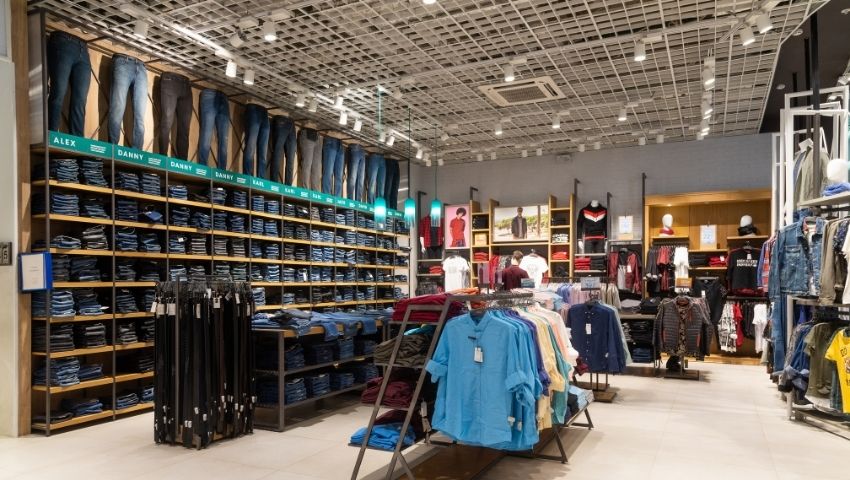
General-Lighting-for-Retail-Shop
- Recommended Light Levels: For general lighting, a range of 30 to 50 footcandles is suggested. This level of illumination is sufficient for minimal lighting of merchandise while enabling staff to efficiently perform tasks such as cleaning, restocking, and managing customer circulation throughout the store. Diffused general lighting fosters a sense of well-being, enhancing customer comfort and encouraging them to stay longer. One effective method to achieve this is by strategically positioning recessed fixtures with reflectors, baffles, and lensed trims in overlapping patterns.
- Perimeter Lighting: Perimeter lighting, or wall washing, is instrumental in defining merchandising spaces and providing vertical illumination, which can make the retail area appear more expansive. Utilizing sconces or wall washers, vertical lighting creates a welcoming ambiance and enhances the visibility and visual impact of wall displays. Illuminating vertical surfaces is crucial for visual comfort and spatial perception, aiding customer orientation and contributing to an impression of openness and hospitality. This vertical brightness not only influences the overall aesthetic but also serves as a directional cue, guiding customers through the store and making the space appear larger and more inviting.
Task Lighting
Task lighting is employed to illuminate specific areas for particular tasks, providing focused, localized, and heightened levels of illumination. It is vital for the functionality of a space, and using energy-efficient sources is crucial for reducing operating costs.
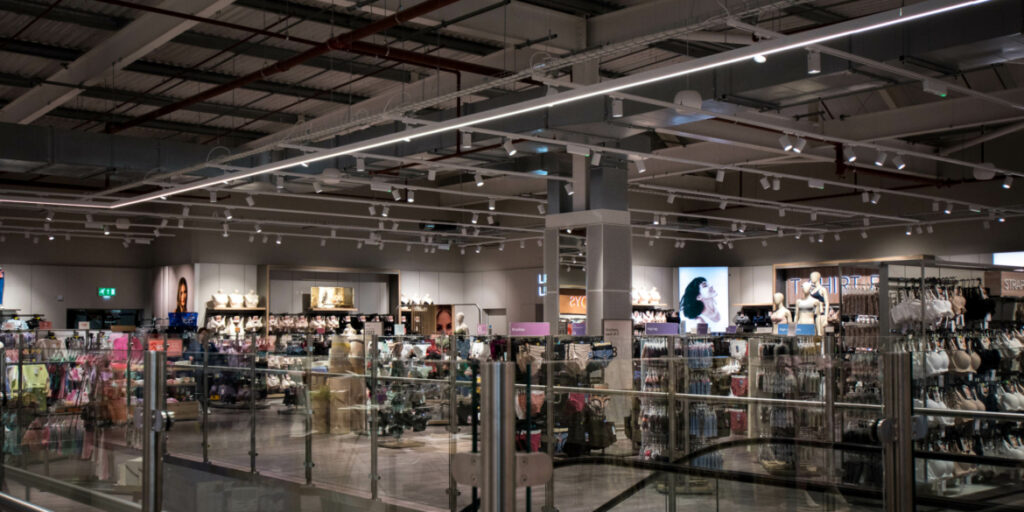
Task-Lighting
- Application and Effectiveness: Task lighting is most effective when it supplements general lighting in workspaces, conference areas, and countertops. Effective task lighting should eliminate shadows on the specific area while preventing glare from the lamp or reflective surfaces.
- Point of Sale: Completing the sale is the most critical retail task, marking the final interaction between the customer and staff. Pendant luminaires at the point of sale are an excellent method for providing task lighting, enabling staff to efficiently and accurately wrap packages, process register sales, and handle credit card transactions, thereby minimizing mistakes and returns. Recommended light levels for task areas range from 50 to 200 footcandles. When illuminating a task area, consider the brightness difference, or contrast, between the task area and the surrounding space. A 3:1 ratio of task lighting to general illumination provides an optimal contrast for evaluating merchandise, reading tags, labels, or packaging, and identifying store departments.
- Flexibility and Adjustability: The amount of light required for tasks, or luminance, is typically the most adjustable variable in task lighting and can be increased to compensate for low contrast levels. This flexibility ensures that task areas are adequately lit for various activities, enhancing overall functionality and efficiency.
Accent Lighting
Accent lighting creates dramatic emphasis on merchandise through focused or point light sources. This technique adds depth, and contrast, and establishes a focal point for displayed items, highlighting their shape, texture, finish, and color, thereby drawing customer attention. However, if the light is directed imprecisely, it can result in unwanted shadows that obstruct the details of the merchandise and produce distracting glare.
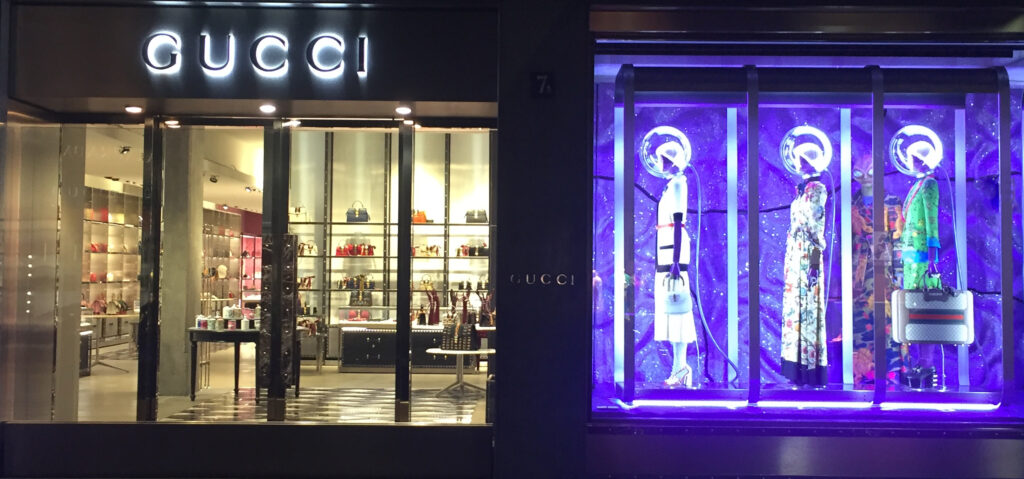
accent lighting in retail stores
- Precision and Intensity: The key to effective accent lighting is ensuring that it is more precise and of higher intensity than the surrounding ambient light. Track fixtures, recessed housings with adjustable trims, and concealed adjustable illumination with point source lamps offer directional control, making them particularly effective for accent lighting. These options can be precisely aimed to highlight products’ best attributes, significantly influencing customer impressions. It is crucial to avoid over-lighting, which can negate the intended impact.
- Optimal Ratios: The Illuminating Engineering Society of North America (IESNA) recommends a 5:1 ratio of accent lighting to ambient light to ensure merchandise stands out and creates a significant visual effect. Darker merchandise may require a higher ratio to bring out details. Recommended light levels for accent lighting range from 150 to 500 footcandles. For feature displays, especially in showcasing items like jewelry or crystal, higher ratios of 15:1 or even 30:1 are employed to create an eye-catching sparkle.
- Implementation and Impact: Properly implemented accent lighting not only highlights key merchandise but also enhances the overall aesthetic appeal of the retail space. By thoughtfully directing light, retailers can guide customer focus, enhance the visual experience, and ultimately drive sales.
Decorative Lighting
Decorative lighting fulfills a dual role: it enhances the aesthetic appeal of retail space while contributing to the overall illumination strategy. This category includes pendants, sconces, chandeliers, table and floor lamps, and cylinders. Properly implemented, decorative lighting complements the interior design, adding visual interest and reinforcing the store’s brand image.
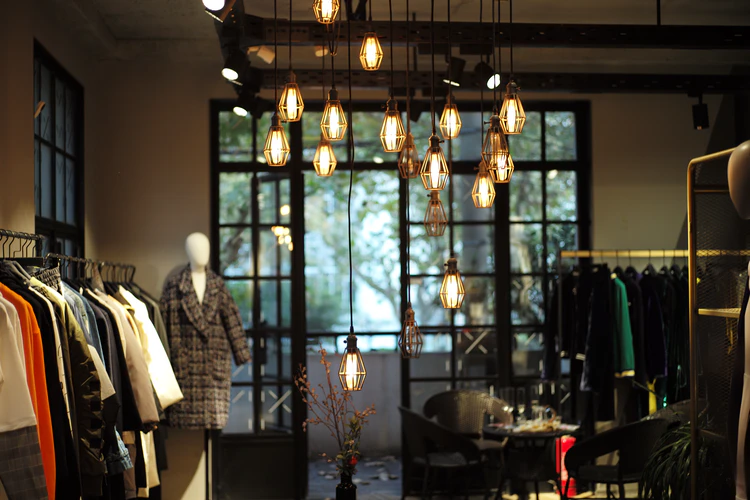
decorative lighting for retail shop
- Pendants and Placement: Pendants should be mounted 8 to 12 feet above the finished floor (a.f.f.) to remain within view without obstructing the shopping experience. When positioned over counters, they should hang 36 to 48 inches above the horizontal plane, allowing customers to see into glass displays without hindrance.
- Wall Sconces and Cylinders: Wall sconces and wall-mounted cylinders should be installed approximately 5.5 feet a.f.f. This height helps to create a sense of human scale, especially important in expansive retail environments.
- Aesthetic and Branding Impact: Decorative lighting is a key element in reflecting the store’s brand image, reinforcing the theme and style of the space. It adds a layer of décor, beauty, and style that contributes to a welcoming atmosphere. By making the retail environment feel hospitable and comfortable, decorative lighting encourages longer customer visits, potentially increasing sales.
- Combining Lighting Layers: Integrating decorative lighting with general, task, and accent lighting layers results in a more attractive, exciting, and inviting store environment. This holistic approach to lighting design ensures that the retail space is not only well-lit but also visually engaging and aligned with the store’s overall aesthetic.
Application Solutions
Achieving exceptional retail lighting design involves numerous factors, all aimed at one ultimate objective: increasing sales. Intelligent lighting enhances merchandise visibility and creates an atmosphere of well-being, thereby boosting the likelihood of purchases. At LEDAPLUS, we strive to balance lighting efficacy, cost efficiency, and flexibility. Our extensive selection of fixtures is designed to optimize merchandise presentation while minimizing ongoing operational expenses.
Storefront Lighting
In the competitive world of retail, capturing a customer’s attention is paramount. The retail window serves as a pivotal attraction, bridging the gap between passersby and the merchandise within the store. To captivate customers, infuse drama into your displays. Utilize intense white light with uniform, saturated illumination. Direct accent lighting should highlight and define the merchandise, creating a visual magnet that draws consumers inside and engages them in the sales experience.
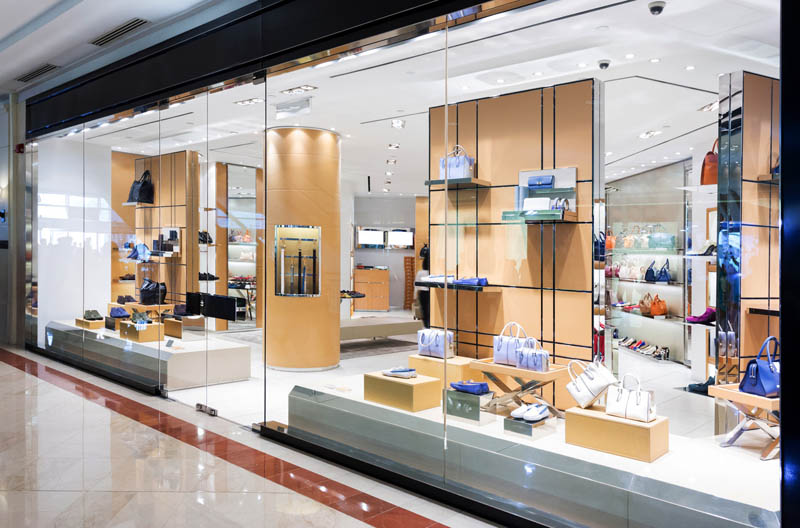
Window Lighting
Daylight, an often overlooked yet energy-efficient lighting solution, can add a compelling dimension to retail spaces. Understanding how natural light interacts with the store’s interior can enhance the visual appeal of merchandise. Window lighting should adapt to the time of day. During daylight hours, strong accent lighting focused on the merchandise will capture more attention. At night, combining low ambient lighting with strong accent lights can pique viewers’ interest.
The store entrance must be brightly illuminated to stand out against the surrounding light, particularly under canopy lighting, which requires additional protection. This high level of brightness should be discernible from a distance, ensuring a compelling first impression. The quality of entrance lighting is crucial, influencing whether potential customers decide to enter the store.
Shelf, Case & Counter Lighting
Illuminating shelves, cases, and counters requires precision to enhance product appeal and attract customer attention. The prevalent method involves using compact sources like LED tape lights positioned close to the display items but concealed from direct view. It is crucial to illuminate these spaces creatively to elevate product desirability. Illuminance levels should exceed ambient lighting by 3-5 times, ensuring that merchandise is prominently highlighted for easy evaluation by customers.
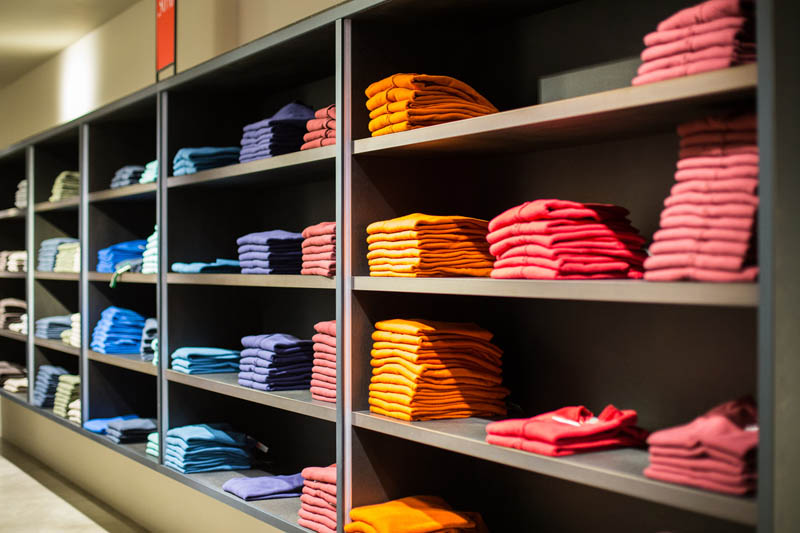
Shelf, Case & Counter Lighting
Selecting the appropriate color temperature and Color Rendering Index (CRI) for the light source is essential to avoid distorting or damaging the appearance of the displayed merchandise. The direction of light on shelves plays a pivotal role; backlighting can create a more visually appealing effect compared to solely using accent lighting. Lower shelves often go unnoticed; however, by strategically placing accent lighting or backlighting on the lower third of the shelves, customers are encouraged to linger, thereby increasing the likelihood of purchases.
Rack Lighting
Rack lighting serves a dual purpose: it captivates customers and facilitates effortless assessment of merchandise. This lighting system must achieve two essential objectives: comprehensive illumination of the merchandise and precise representation of color and texture. Given the ever-evolving nature of display requirements, maintaining flexibility within this system is paramount. The LEDAPLUS track lighting systems are exemplary, as they permit the addition, removal, or repositioning of fixtures without the necessity of deactivating power to the track. The illuminance on merchandise should be maintained at a minimum of three to five times the ambient lighting levels.
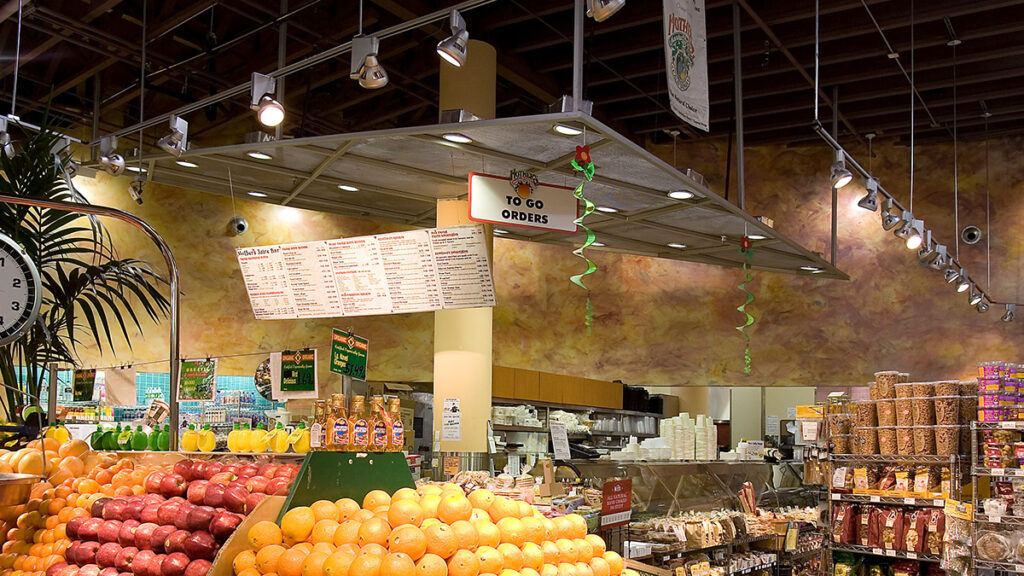
rack lighting for retail shop
Fitting Room Lighting
Optimal dressing room lighting is crucial, as it significantly influences purchasing decisions. Employing high-quality illumination with an elevated color rendering index is essential to highlight the form and texture of merchandise, ensuring colors appear authentic and vivid. The color perception of the merchandise in the fitting room must mirror that on the sales floor. Utilizing lamp sources with congruent CRIs and CCTs ensures visual consistency between these areas.
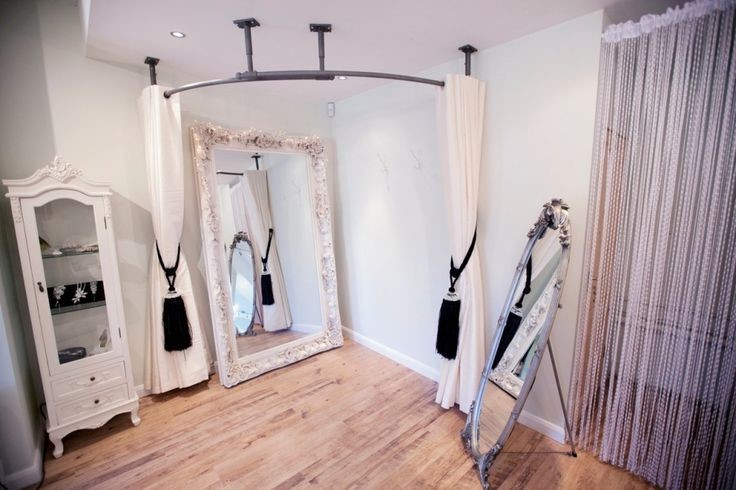
Fitting Room Lighting retail
Conventionally, most fitting rooms are lit by overhead fluorescent fixtures. However, integrating both diffused and directional light sources with superior CRI can offer more flattering illumination. This dual-lighting approach enhances the appearance of both customers and merchandise. Strategic fixture placement is imperative to eliminate shadows, particularly when reflected in mirrors. It is the customer, not the mirror, who should be illuminated.
Incorporating energy-efficient lighting technologies in fitting rooms presents additional advantages. These lights emit less heat, thereby reducing the cooling load and enhancing the comfort of the dressing rooms, while simultaneously lowering overall energy expenses.
Exit & Emergency Lighting
LEDAPLUS presents a range of premium exit and emergency lighting solutions tailored to your environment. These fixtures play a crucial role in directing occupants safely during general lighting failures. In situations where evacuation is unnecessary, the lighting ensures security and comfort until normal lighting conditions are reinstated.
LEDAPLUS’s exit and emergency fixtures undergo rigorous testing to uphold the highest safety benchmarks, surpassing requirements set by NFPA101, NEC, and UL294 standards.
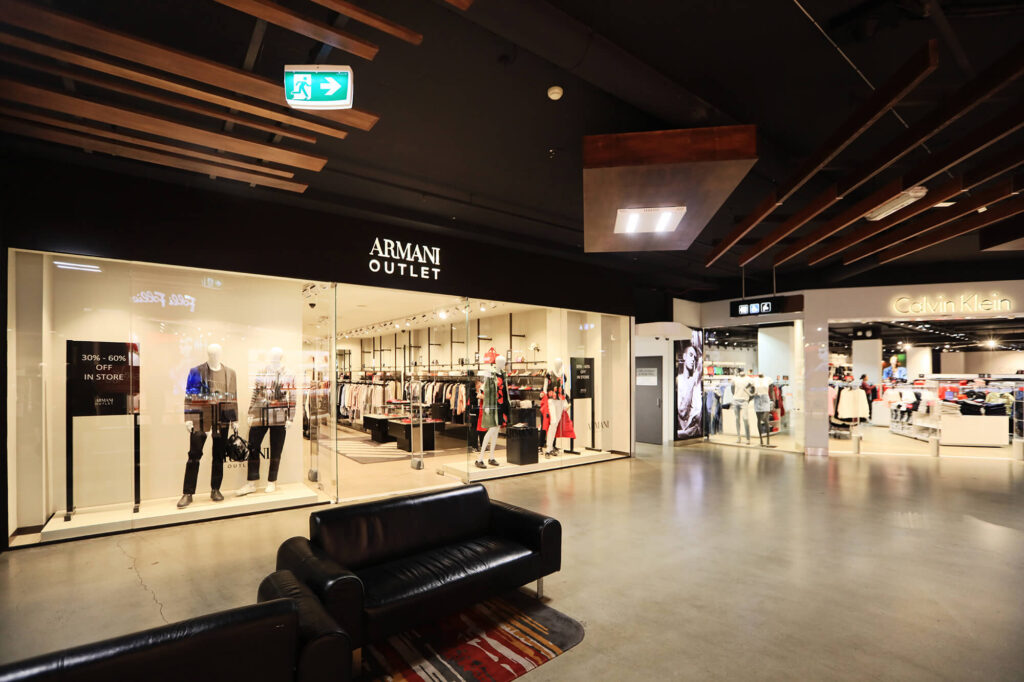
Exit & Emergency Lighting retail shop
Conclusion
Achieving a balance between lighting effects, affordability, and adaptability is crucial in retail lighting design. Intelligent lighting design not only enhances the appearance of merchandise but also contributes significantly to the overall shopping experience and sales performance. By focusing on key characteristics such as energy efficiency, flexibility, and maintenance, retailers can create a lighting plan that supports their business goals and brand image.
FAQ
By following these guidelines and considering the key aspects of retail lighting design, retailers can create an inviting and effective shopping environment that enhances customer satisfaction and drives sales.
